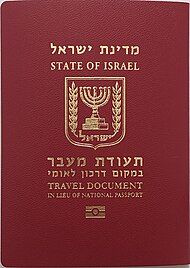Israeli travel document in lieu of national passport
| Israeli travel document in lieu of national passport | |
|---|---|
 The front cover of a contemporary Israeli biometric travel document in lieu of national passport | |
| Type | Travel document |
| Issued by | |
| Purpose | Identification |
| Eligibility | Israeli citizenship |
| Expiration | between 2 weeks and 5 years after issuance |
| Cost | between 100 and 300 NIS[1] |
The Israeli travel document in lieu of national passport (Hebrew: תעודת מעבר במקום דרכון לאומי Teudat ma'avar bimkom darkon leumi), commonly called Israeli laissez-passer (e.g. at Cabinet of Israel's official website[2]), is a travel document (provisional passport) issued to the citizens of the State of Israel who do not qualify for an ordinary Israeli passport e.g. if they do not reside in Israel or have lost regular passport several times.
It should not be confused with Israeli travel documents issued to non-citizens such as stateless residents of East Jerusalem and non-Israeli residents of the Golan Heights, as well as foreigners who need to leave Israel and are unable to obtain a passport from their country of nationality. The nationality is explicitly written on the page with a holder's photo.
As of 15 September 2023, Teudat maavar is accepted as a legitimate document by all EU and Schengen countries except Malta,[3] as well as by Japan, South Korea, and others.[4]
Eligibility
[edit]Most Israelis travel on ordinary Israeli passports (Hebrew: דרכונים). Travel documents in lieu of a national passport are issued in specific circumstances, which include:
- Olim (Jewish immigrants under the Law of Return) and other naturalized Israeli citizens who do not reside in Israel permanently;
- Israeli citizens who have lost or damaged more than two passports in the course of 10 years;
- Israeli citizens who have not been to Israel for over 10 years.[5]
Status
[edit]Although travel document in lieu of national passport is the official name of the document used in the Israeli law and printed on its cover, the biodata page has no mentions of it being a travel document in the strict sense.[6] Instead, it features the name provisional passport in English. The document type position in the machine-readable zone, too, reads PP which stands for "passport; temporary / provisional / emergency".[7] This has been a major source of confusion for both travelers and institutions dealing with travelers, since ordinary passports, provisional passports and refugee travel documents are treated differently by many airlines and border control agencies, and assignment of Israeli travel documents in lieu of national passport to one of these categories often depends on the incorrect personal opinion of a specific foreign official.
Types
[edit]Depending on the issuing authority and specific circumstances of a citizen who is being issued a travel document in lieu of national passport, validity terms may vary. Israelis who have been absent from the country for 10 or more years are usually issued a travel document valid for just two weeks intended to be used for a single entry to Israel, where they can then apply for an ordinary passport. Biometric travel documents for olim not permanently resident in Israel are valid for 5 years, if issued by the Israeli Ministry of Interior. Israeli diplomatic missions around the world only issue non-biometric documents.
Visa requirements
[edit]The Israeli Ministry of Foreign Affairs maintains that travel documents in lieu of national passport are intended primarily for entering and leaving Israel. Using them for traveling to other countries is allowed, but visa-free access is not guaranteed. According to the official website of Israeli diplomatic missions, mutual agreements between Israel and other countries regarding visa exemptions do not necessarily apply to holders of this document.[5]
Nevertheless, multiple countries such as France,[8] Serbia[9] and the Czech Republic[10] clearly state that holders of Israeli travel documents in lieu of national passport are entitled to visa-free access under the same conditions as ordinary Israeli passport holders. Conversely, several other countries such as Canada and the United Kingdom explicitly state that Israeli travel document in lieu of national passport holders do require a visa, while ordinary Israeli passport holders do not.[11]
According to the PRADO (Public Register of Authentic Identity and Travel Documents Online) database maintained by the European Council, only one Schengen Area member-state, Malta, does not accept Israeli travel documents in lieu of national passport as a valid proof of identity for crossing their borders, which means holders of these documents will not be able to enter these countries regardless of having or not having a visa.[12]
References
[edit]- ^ "Apply for an Israeli travel document (laissez passer) for Israeli citizens", Government of Israel, retrieved 2023-02-11
- ^ "Apply for an Israeli travel document (laissez passer) for Israeli citizens". gov.il.
- ^ "Travel documents issued by third countries and territorial entities (Part I)". home-affairs.ec.europa.eu. Retrieved 2023-09-08.
- ^ "Лессе пассе - список стран". Алия (in Russian). Retrieved 2023-09-08.
- ^ a b "Passports and Travel Documents", Embassy of Israel in New Zealand, 2022-05-23, retrieved 2023-02-11
- ^ Although all proofs of identity valid for crossing borders, including ordinary passports, are technically travel documents, most papers with "travel document" in their name are issued to stateless people and refugees and treated differently than national passports by border officials in most countries.
- ^ "Document: ISR-AP-03001", PRADO, retrieved 2023-02-11
- ^ "Particular situations. Israel", France-Visas, retrieved 2023-02-11
- ^ "Visa regime for entering Serbia", Republic of Serbia Ministry of Foreign Affairs, retrieved 2023-02-11
- ^ "Information for Holders of Travel Document in Lieu of National Passport", Embassy of the Czech Republic in Tel Aviv, 2021-11-17, retrieved 2023-02-11
- ^ "Entry requirements by country or territory", Government of Canada, retrieved 2023-02-11
- ^ "Recognized travel documents", PRADO, retrieved 2023-09-20
